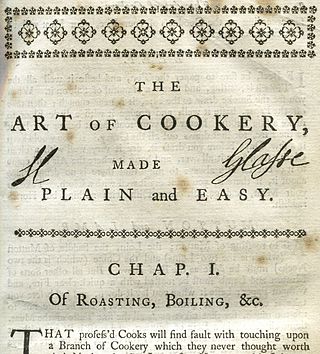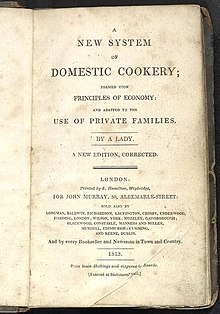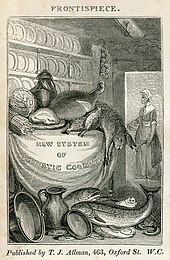
Isabella Mary Beeton, known as Mrs Beeton, was an English journalist, editor and writer. Her name is particularly associated with her first book, the 1861 work Mrs Beeton's Book of Household Management. She was born in London and, after schooling in Islington, north London, and Heidelberg, Germany, she married Samuel Orchart Beeton, an ambitious publisher and magazine editor.

Shepherd's pie, cottage pie, or in its French version hachis Parmentier is a savoury dish of cooked minced meat topped with mashed potato and baked, formerly also called Sanders or Saunders. The meat used may be either previously cooked or freshly minced. The usual meats are beef or lamb. The two English terms have been used interchangeably since they came into use in the late 18th and the early 19th century, although some writers insist that a shepherd's pie should contain lamb or mutton, and a cottage pie, beef.

Bakewell pudding is an English dessert consisting of a flaky pastry base with a layer of sieved jam and topped with a filling made of egg and almond paste.

Mrs. Beeton's Book of Household Management, also published as Mrs. Beeton's Cookery Book, is an extensive guide to running a household in Victorian Britain, edited by Isabella Beeton and first published as a book in 1861. Previously published in parts, it initially and briefly bore the title Beeton's Book of Household Management, as one of the series of guidebooks published by her husband, Samuel Beeton. The recipes were highly structured, in contrast to those in earlier cookbooks. It was illustrated with many monochrome and colour plates.

Eliza Acton was an English food writer and poet who produced one of Britain's first cookery books aimed at the domestic reader, Modern Cookery for Private Families. The book introduced the now-universal practice of listing ingredients and giving suggested cooking times for each recipe. It included the first recipes in English for Brussels sprouts and for spaghetti. It also contains the first recipe for what Acton called "Christmas pudding"; the dish was normally called plum pudding, recipes for which had appeared previously, although Acton was the first to put the name and recipe together.

The Art of Cookery Made Plain and Easy is a cookbook by Hannah Glasse (1708–1770) first published in 1747. It was a bestseller for a century after its first publication, dominating the English-speaking market and making Glasse one of the most famous cookbook authors of her time. The book ran through at least 40 editions, many of which were copied without explicit author consent. It was published in Dublin from 1748, and in America from 1805.

Hannah Glasse was an English cookery writer of the 18th century. Her first cookery book, The Art of Cookery Made Plain and Easy, published in 1747, became the best-selling recipe book that century. It was reprinted within its first year of publication, appeared in 20 editions in the 18th century, and continued to be published until well into the 19th century. She later wrote The Servants' Directory (1760) and The Compleat Confectioner, which was probably published in 1760; neither book was as commercially successful as her first.
A collop is a slice of meat, according to one definition in the Oxford English Dictionary. In Elizabethan times, "collops" came to refer specifically to slices of bacon. Shrove Monday, also known as Collop Monday, was traditionally the last day to cook and eat meat before Ash Wednesday, which was a non-meat day in the pre-Lenten season also known as Shrovetide. A traditional breakfast dish was collops of bacon topped with a fried egg.

The Compleat Housewife; or, Accomplish'd Gentlewoman's Companion is a cookery book written by Eliza Smith and first published in London in 1727. It became popular, running through 18 editions in fifty years.

Fricassee or fricassée is a stew made with pieces of meat that have been browned in butter then served in a sauce flavored with the cooking stock. Fricassee is usually made with chicken, veal or rabbit, with variations limited only by what ingredients the cook has at hand.

Eliza Leslie (1787–1858), frequently referred to as Miss Leslie, was an American author of popular cookbooks during the nineteenth century. She also wrote household management books, etiquette books, novels, short stories and articles for magazines and newspapers.

Elizabeth Raffald was an English author, innovator and entrepreneur.

Maria Eliza Rundell was an English writer. Little is known about most of her life, but in 1805, when she was over 60, she sent an unedited collection of recipes and household advice to John Murray, of whose family—owners of the John Murray publishing house—she was a friend. She asked for, and expected, no payment or royalties.

The Experienced English Housekeeper is a cookery book by the English businesswoman Elizabeth Raffald (1733–1781). It was first published in 1769, and went through 13 authorised editions and at least 23 pirated ones.

The Housekeeper's Instructor was a bestselling English cookery book written by William Augustus Henderson, 1791. It ran through seventeen editions by 1823. Later editions were revised by Jacob Christopher Schnebbelie.

Modern Cookery for Private Families is an English cookery book by Eliza Acton. It was first published by Longmans in 1845, and was a best-seller, running through 13 editions by 1853, though its sales were later overtaken by Mrs Beeton. On the strength of the book, Delia Smith called Acton "the best writer of recipes in the English language", while Elizabeth David wondered why "this peerless writer" had been eclipsed by such inferior and inexperienced imitators.
Elizabeth Goodfellow (c.1767–1851), generally called Mrs. Goodfellow, started one of the first cooking schools in America. She taught classes for thirty years, and her recipes and techniques were passed on for generations in the cookbooks of one of her students, Eliza Leslie. Goodfellow also ran a renowned bakery and confectionery in Philadelphia during the first fifty years of the 19th century.
Battalia pie is an English large game pie, or occasionally a fish pie, filled with many small "blessed" pieces, beatilles, of offal, in a gravy made from meat stock flavoured with spices and lemon. The dish was described in cookery books of the 17th and 18th centuries.

The Queen-like Closet, Or, Rich Cabinet was a cookery book published in 1670 by the English writer on household management, Hannah Woolley. It ran through five English editions by 1684. At least two German editions were also printed.

The Lady's Complete Guide, or Cookery in All its Branches by Mary Cole is a pioneering cookery book, the first in English that systematically ascribed recipes to their authors, where known. It was first published in 1788 and was followed by revised editions in 1789 and 1791.




















